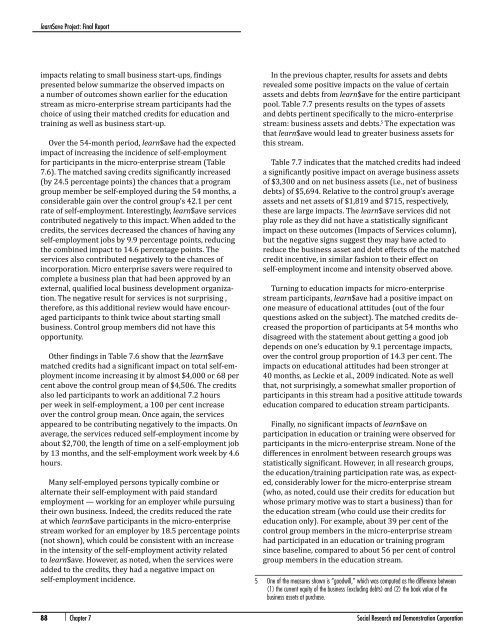Full report. - Social Research and Demonstration Corp
Full report. - Social Research and Demonstration Corp
Full report. - Social Research and Demonstration Corp
You also want an ePaper? Increase the reach of your titles
YUMPU automatically turns print PDFs into web optimized ePapers that Google loves.
learn$ave Project: Final Reportimpacts relating to small business start-ups, findingspresented below summarize the observed impacts ona number of outcomes shown earlier for the educationstream as micro-enterprise stream participants had thechoice of using their matched credits for education <strong>and</strong>training as well as business start-up.Over the 54-month period, learn$ave had the expectedimpact of increasing the incidence of self-employmentfor participants in the micro-enterprise stream (Table7.6). The matched saving credits significantly increased(by 24.5 percentage points) the chances that a programgroup member be self-employed during the 54 months, aconsiderable gain over the control group’s 42.1 per centrate of self-employment. Interestingly, learn$ave servicescontributed negatively to this impact. When added to thecredits, the services decreased the chances of having anyself-employment jobs by 9.9 percentage points, reducingthe combined impact to 14.6 percentage points. Theservices also contributed negatively to the chances ofincorporation. Micro enterprise savers were required tocomplete a business plan that had been approved by anexternal, qualified local business development organization.The negative result for services is not surprising ,therefore, as this additional review would have encouragedparticipants to think twice about starting smallbusiness. Control group members did not have thisopportunity.Other findings in Table 7.6 show that the learn$avematched credits had a significant impact on total self-employmentincome increasing it by almost $4,000 or 68 percent above the control group mean of $4,506. The creditsalso led participants to work an additional 7.2 hoursper week in self-employment, a 100 per cent increaseover the control group mean. Once again, the servicesappeared to be contributing negatively to the impacts. Onaverage, the services reduced self-employment income byabout $2,700, the length of time on a self-employment jobby 13 months, <strong>and</strong> the self-employment work week by 4.6hours.Many self-employed persons typically combine oralternate their self-employment with paid st<strong>and</strong>ardemployment — working for an employer while pursuingtheir own business. Indeed, the credits reduced the rateat which learn$ave participants in the micro-enterprisestream worked for an employer by 18.5 percentage points(not shown), which could be consistent with an increasein the intensity of the self-employment activity relatedto learn$ave. However, as noted, when the services wereadded to the credits, they had a negative impact onself-employment incidence.In the previous chapter, results for assets <strong>and</strong> debtsrevealed some positive impacts on the value of certainassets <strong>and</strong> debts from learn$ave for the entire participantpool. Table 7.7 presents results on the types of assets<strong>and</strong> debts pertinent specifically to the micro-enterprisestream: business assets <strong>and</strong> debts. 5 The expectation wasthat learn$ave would lead to greater business assets forthis stream.Table 7.7 indicates that the matched credits had indeeda significantly positive impact on average business assetsof $3,300 <strong>and</strong> on net business assets (i.e., net of businessdebts) of $5,694. Relative to the control group’s averageassets <strong>and</strong> net assets of $1,819 <strong>and</strong> $715, respectively,these are large impacts. The learn$ave services did notplay role as they did not have a statistically significantimpact on these outcomes (Impacts of Services column),but the negative signs suggest they may have acted toreduce the business asset <strong>and</strong> debt effects of the matchedcredit incentive, in similar fashion to their effect onself-employment income <strong>and</strong> intensity observed above.Turning to education impacts for micro-enterprisestream participants, learn$ave had a positive impact onone measure of educational attitudes (out of the fourquestions asked on the subject). The matched credits decreasedthe proportion of participants at 54 months whodisagreed with the statement about getting a good jobdepends on one’s education by 9.1 percentage impacts,over the control group proportion of 14.3 per cent. Theimpacts on educational attitudes had been stronger at40 months, as Leckie et al., 2009 indicated. Note as wellthat, not surprisingly, a somewhat smaller proportion ofparticipants in this stream had a positive attitude towardseducation compared to education stream participants.Finally, no significant impacts of learn$ave onparticipation in education or training were observed forparticipants in the micro-enterprise stream. None of thedifferences in enrolment between research groups wasstatistically significant. However, in all research groups,the education/training participation rate was, as expected,considerably lower for the micro-enterprise stream(who, as noted, could use their credits for education butwhose primary motive was to start a business) than forthe education stream (who could use their credits foreducation only). For example, about 39 per cent of thecontrol group members in the micro-enterprise streamhad participated in an education or training programsince baseline, compared to about 56 per cent of controlgroup members in the education stream.5 One of the measures shown is “goodwill,” which was computed as the difference between(1) the current equity of the business (excluding debts) <strong>and</strong> (2) the book value of thebusiness assets at purchase.88 | Chapter 7 <strong>Social</strong> <strong>Research</strong> <strong>and</strong> <strong>Demonstration</strong> <strong>Corp</strong>oration




